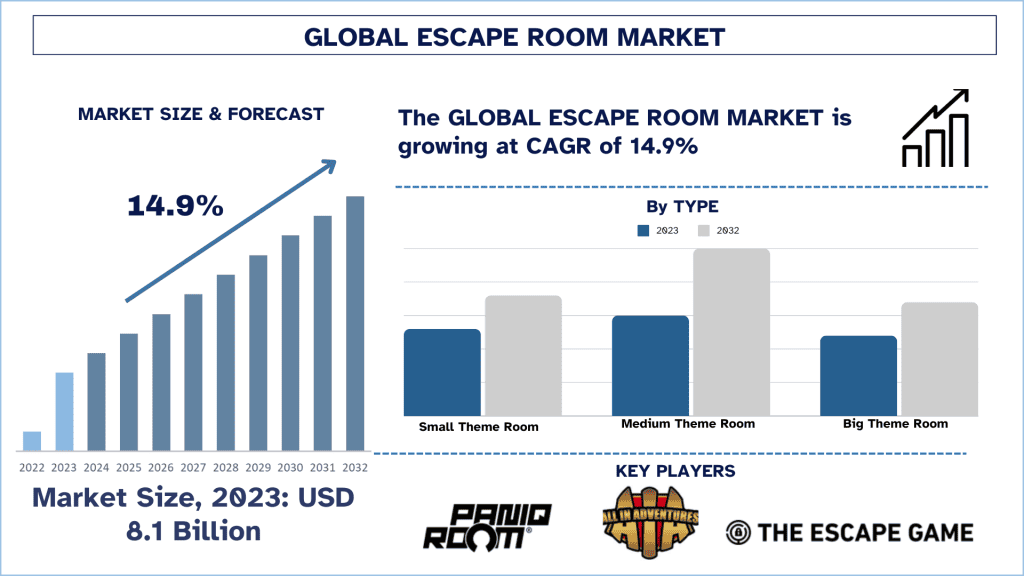- Inicio
- Acerca de nosotros
- Industria
- Servicios
- Leyendo
- Contáctenos
Mercado de Escape Rooms: Análisis Actual y Pronóstico (2024-2032)
Énfasis en el Tipo (Sala Temática Pequeña, Sala Temática Mediana y Sala Temática Grande); Temáticas (Misterio, Terror y Otros); Tipo de Reserva (Reserva Online y Reserva In Situ); Usuario Final (Grupos Corporativos, Familias, Parejas y Otros) y Región/País
Tamaño y Pronóstico del Mercado de Escape Rooms
El mercado de Escape Rooms se valoró en aproximadamente ~USD 8.1 mil millones en 2023 y se espera que crezca a una sólida CAGR de alrededor del 14.9% durante el período de pronóstico (2024-2032) debido a los crecientes avances tecnológicos a nivel mundial.
Análisis del Mercado de Escape Rooms
El mercado de escape rooms presenta servicios de entretenimiento que implican resolver acertijos y buscar pistas en habitaciones cerradas con tiempo limitado para escapar. La demanda de eventos diferenciados y entretenidos está impulsando al mercado a diversificar las temáticas e introducir niveles más altos de avance tecnológico entre sus participantes, que van desde familias hasta grandes empresas y corporaciones. Debido al desarrollo continuo de nuevas tecnologías y mercados geográficos, el mercado de escape rooms sigue siendo popular y ofrece experiencias únicas y una mejor cooperación en equipo. Las colaboraciones de empresas, las adquisiciones y los lanzamientos innovadores de productos también impulsan el crecimiento de la industria.
En abril de 2022, Breakout lanzó un nuevo juego de escape room en Melaka con este nuevo punto de venta que consta de 8 nuevas salas temáticas, además de las 12 salas ya existentes en los puntos de venta de Kuala Lumpur.
En abril de 2024, el Centro Nacional para Niños Desaparecidos y Explotados (NCMEC) presentó “No Escape Room”, una nueva y emocionante experiencia interactiva que sumerge a padres y cuidadores en la realidad de la extorsión sexual financiera, coincidiendo con la publicación de nuevos datos sobre la explotación sexual infantil.
Tendencias del Mercado de Escape Rooms
Esta sección analiza las tendencias clave del mercado que están influyendo en los diversos segmentos del mercado de escape rooms, ya que
El Terror Segmento que Transforma la Industria
El segmento de terror trata con la población interesada en la emoción y la experiencia aterradora como un tipo de escape room. Este género involucra por completo a las personas en tales condiciones durante varias horas porque la atmósfera es bastante oscura, basada en la creación de miedo, y contiene elementos como fondos extraños, sonidos y tramas sombrías. Combinando estos temas de terror con acertijos elaborados e historias atractivas, las salas de escape con temática de terror brindan una experiencia distintiva de alto riesgo que será atractiva para ese tipo de invitados. Los temas distintivos, los escenarios oscuros y los acertijos complejos les resultan satisfactorios. Este segmento ha ganado popularidad a lo largo de los años, ya que brinda a las personas la oportunidad de demostrar su valentía y resolver acertijos en lo que puede describirse como un entorno controlado.
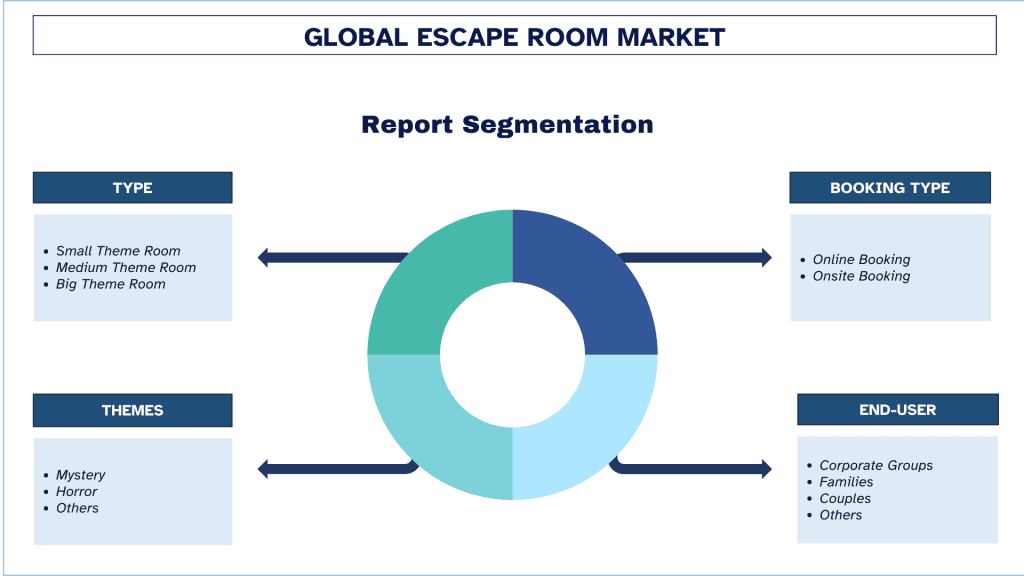
Se espera que América del Norte crezca a un ritmo significativo en el período de pronóstico.
El desarrollo del mercado de escape rooms en América del Norte puede caracterizarse como constante debido a la demanda de los consumidores de tipos de entretenimiento más atractivos. Los mercados de interacciones y entretenimiento en el área han seguido creciendo, y las personas y las empresas han demostrado una propensión a organizar eventos sociales y corporativos, aumentando así las perspectivas de las escape rooms como actividades de entretenimiento o grupales. La tecnología y la creación de formas nuevas y creativas de contar historias han hecho que estas experiencias sean más interesantes, atrayendo así a muchos clientes. Además, la mayor disponibilidad de sitios de escape room en áreas principalmente urbanas y suburbanas garantiza que este tipo de actividades sean más beneficiosas, aumentando así el crecimiento sostenido del mercado y estableciendo firmemente la presencia de América del Norte como un área crucial en la industria de las escape rooms.
En mayo de 2024, en celebración del Día Internacional de la Diversidad Biológica, la Agencia de los Estados Unidos para el Desarrollo Internacional (USAID) y el Departamento de Medio Ambiente y Recursos Naturales (DENR) lanzaron “Biodiversity Crisis Escape Room”, una nueva y atractiva atracción interactiva en The Mind Museum en la ciudad de Taguig, donde niños y adultos pueden aprender más sobre la protección del mundo natural.
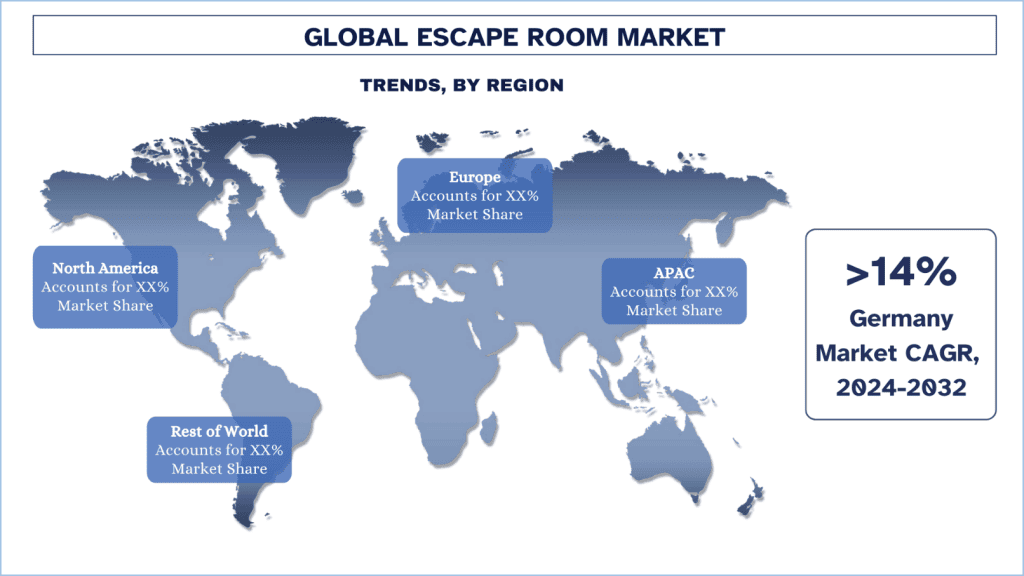
Visión General de la Industria de Escape Rooms
El mercado de escape rooms es competitivo, con varios actores del mercado global e internacional. Los actores clave están adoptando diferentes estrategias de crecimiento para mejorar su presencia en el mercado, como asociaciones, acuerdos, colaboraciones, expansiones geográficas y fusiones y adquisiciones. Algunos de los principales actores que operan en el mercado son PanIQ Escape Room Franchise; Texas Panic Room; Maze Rooms Corp.; THE GREAT ESCAPE ROOM; Breakout; All In Adventures; The Escape Game, LLC; ESCAPOLOGY; Amazing Escape Room, LLC; Epic Escape Game.
En junio de 2024, Chesterfield Escape Rooms lanzó una secuela del popular juego Rob the Bank.
En mayo de 2024, Great Escape Game, con sede en el Reino Unido, en el centro de la ciudad de Sheffield, presentó una nueva experiencia de bar inmersiva para los buscadores de fantasmas y los sociales.
En noviembre de 2021, Escape Hunt propuso la adquisición de Boom Battle Bars y un cambio de nombre a XP Factory con el objetivo de la expansión geográfica.
En septiembre de 2021, Beverly Group, unió fuerzas con Superdough, la empresa detrás de Breakout Escape Rooms y Hauntu Horror House, y lanzó LIИDA, una experiencia virtual única desarrollada especialmente para la propiedad One Equine.
Cobertura del Informe de Mercado de Escape Rooms
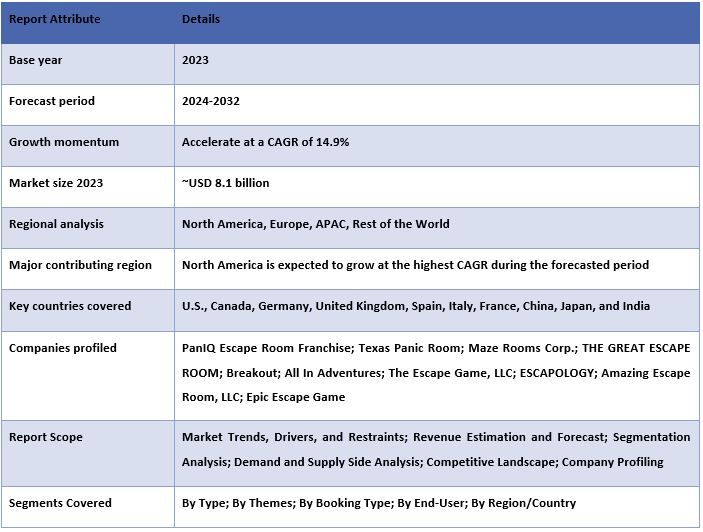
Razones para comprar este informe:
- El estudio incluye el dimensionamiento del mercado y el análisis de pronóstico validados por expertos clave de la industria autenticados.
- El informe presenta una revisión rápida del rendimiento general de la industria de un vistazo.
- El informe cubre un análisis en profundidad de los pares prominentes de la industria con un enfoque principal en las finanzas comerciales clave, las carteras de productos, las estrategias de expansión y los desarrollos recientes.
- Examen detallado de los impulsores, restricciones, tendencias clave y oportunidades que prevalecen en la industria.
- El estudio cubre ampliamente el mercado en diferentes segmentos.
- Análisis de nivel regional de inmersión profunda de la industria.
Opciones de Personalización:
El mercado global de escape rooms se puede personalizar aún más según el requisito o cualquier otro segmento del mercado. Además de esto, UMI entiende que puede tener sus propias necesidades comerciales, por lo tanto, no dude en conectarse con nosotros para obtener un informe que se adapte completamente a sus necesidades.
Tabla de contenido
Metodología de Investigación para el Análisis del Mercado de Escape Rooms (2024-2032)
Analizar el mercado histórico, estimar el mercado actual y pronosticar el mercado futuro del mercado global de escape rooms fueron los tres pasos principales realizados para crear y analizar la adopción de escape rooms en las principales regiones a nivel mundial. Se realizó una extensa investigación secundaria para recopilar los números históricos del mercado y estimar el tamaño actual del mercado. En segundo lugar, para validar estos conocimientos, se tuvieron en cuenta numerosos hallazgos y supuestos. Además, también se realizaron exhaustivas entrevistas primarias con expertos de la industria en toda la cadena de valor del mercado global de escape rooms. Después de la suposición y validación de los números del mercado a través de entrevistas primarias, empleamos un enfoque de arriba hacia abajo/abajo hacia arriba para pronosticar el tamaño completo del mercado. Posteriormente, se adoptaron métodos de desglose del mercado y triangulación de datos para estimar y analizar el tamaño del mercado de los segmentos y subsegmentos de la industria a la que pertenece. La metodología detallada se explica a continuación:
Análisis del Tamaño Histórico del Mercado
Paso 1: Estudio Profundo de Fuentes Secundarias:
Se realizó un estudio secundario detallado para obtener el tamaño histórico del mercado de escape rooms a través de fuentes internas de la empresa, tales comoinformes anuales y estados financieros, presentaciones de rendimiento, comunicados de prensa, etc.,y fuentes externas incluyendorevistas, noticias y artículos, publicaciones gubernamentales, publicaciones de la competencia, informes del sector, bases de datos de terceros y otras publicaciones creíbles.
Paso 2: Segmentación del Mercado:
Después de obtener el tamaño histórico del mercado de escape rooms, realizamos un análisis secundario detallado para recopilar información histórica del mercado y compartir para diferentes segmentos y subsegmentos para las principales regiones. Los principales segmentos están incluidos en el informe, como el tipo, las temáticas, el tipo de reserva, el usuario final y las regiones. Además, se realizaron análisis a nivel de país para evaluar la adopción general de modelos de prueba en esa región.
Paso 3: Análisis de Factores:
Después de adquirir el tamaño histórico del mercado de diferentes segmentos y subsegmentos, realizamos un detalladoanálisis de factorespara estimar el tamaño actual del mercado del mercado de salas de escape. Además, realizamos un análisis factorial utilizando variables dependientes e independientes, como el tipo, temas, tipo de reserva, usuario final y regiones del mercado de salas de escape. Se realizó un análisis exhaustivo de los escenarios de la oferta y la demanda, considerando las principales asociaciones, fusiones y adquisiciones, la expansión comercial y los lanzamientos de productos en el sector del mercado de salas de escape en todo el mundo.
Estimación y pronóstico del tamaño actual del mercado
Dimensionamiento actual del mercado:Basándonos en información práctica de los 3 pasos anteriores, llegamos al tamaño actual del mercado, los actores clave en el mercado global de salas de escape y las cuotas de mercado de los segmentos. Todas las cuotas porcentuales requeridas y los desgloses del mercado se determinaron utilizando el enfoque secundario mencionado anteriormente y se verificaron a través de entrevistas primarias.
Estimación y pronóstico:Para la estimación y el pronóstico del mercado, se asignaron ponderaciones a diferentes factores, incluidos los impulsores y las tendencias, las restricciones y las oportunidades disponibles para las partes interesadas. Después de analizar estos factores, se aplicaron técnicas de pronóstico relevantes, es decir, el enfoque de arriba hacia abajo/de abajo hacia arriba, para llegar al pronóstico del mercado para 2032 para diferentes segmentos y subsegmentos en los principales mercados a nivel mundial. La metodología de investigación adoptada para estimar el tamaño del mercado abarca:
- El tamaño del mercado de la industria, en términos de ingresos (USD) y la tasa de adopción del mercado de salas de escape en los principales mercados a nivel nacional.
- Todas las cuotas porcentuales, divisiones y desgloses de los segmentos y subsegmentos del mercado.
- Actores clave en el mercado global de salas de escape en términos de productos ofrecidos. Además, las estrategias de crecimiento adoptadas por estos actores para competir en el mercado de rápido crecimiento.
Validación del tamaño y la cuota de mercado
Investigación primaria:Se realizaron entrevistas en profundidad con los líderes de opinión clave (KOL), incluidos los ejecutivos de alto nivel (CXO/VPs, Jefe de Ventas, Jefe de Marketing, Jefe de Operaciones, Jefe Regional, Jefe de País, etc.) en las principales regiones. Luego, los resultados de la investigación primaria se resumieron y se realizó un análisis estadístico para probar la hipótesis establecida. Las aportaciones de la investigación primaria se consolidaron con los hallazgos secundarios, convirtiendo así la información en información práctica.
División de los participantes principales en diferentes regiones
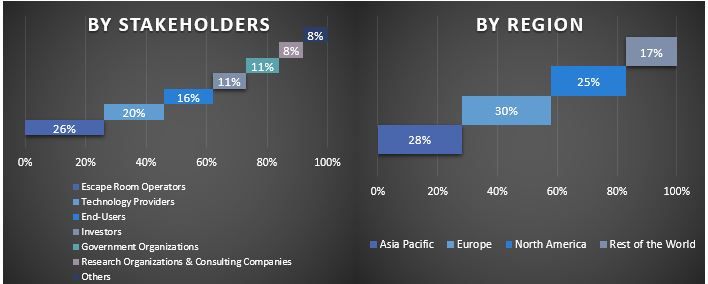
Ingeniería de mercado
La técnica de triangulación de datos se empleó para completar la estimación general del mercado y para obtener números estadísticos precisos para cada segmento y subsegmento del mercado global de salas de escape. Los datos se dividieron en varios segmentos y subsegmentos después de estudiar varios parámetros y tendencias en las áreas del tipo, temas, tipo de reserva, usuario final y regiones en el mercado global de salas de escape.
El principal objetivo del estudio del mercado global de salas de escape
Las tendencias actuales y futuras del mercado global de salas de escape se identificaron en el estudio. Los inversores pueden obtener información estratégica para basar su discreción para las inversiones en el análisis cualitativo y cuantitativo realizado en el estudio. Las tendencias actuales y futuras del mercado determinaron el atractivo general del mercado a nivel regional, proporcionando una plataforma para que el participante industrial explote el mercado sin explotar para beneficiarse de una ventaja de primer motor. Otros objetivos cuantitativos de los estudios incluyen:
- Analizar el tamaño actual y pronosticado del mercado de salas de escape en términos de valor (USD). También analizar el tamaño actual y pronosticado del mercado de diferentes segmentos y subsegmentos.
- Los segmentos en el estudio incluyen áreas del tipo, temas, tipo de reserva, usuario final y regiones.
- Definición y análisis del marco regulatorio para la sala de escape
- Analizar la cadena de valor involucrada con la presencia de varios intermediarios, junto con el análisis de los comportamientos de clientes y competidores de la industria.
- Analizar el tamaño actual y pronosticado del mercado de salas de escape para la región principal.
- Los principales países de las regiones estudiadas en el informe incluyen Asia Pacífico, Europa, América del Norte y el Resto del Mundo
- Perfiles de empresas del mercado de salas de escape y las estrategias de crecimiento adoptadas por los actores del mercado para mantenerse en el mercado de rápido crecimiento.
- Análisis profundo a nivel regional de la industria.
Preguntas frecuentes Preguntas frecuentes
P1: ¿Cuál es el tamaño actual del mercado de escape rooms y su potencial de crecimiento?
P2: ¿Cuáles son los factores impulsores del crecimiento del mercado de escape rooms?
P3: ¿Qué segmento tiene la mayor cuota del mercado de escape rooms por tipo?
P4: ¿Cuáles son las tecnologías y tendencias emergentes en el mercado de escape rooms?
P5: ¿Qué región dominará el mercado de escape rooms?
Relacionados Informes
Los clientes que compraron este artículo también compraron

